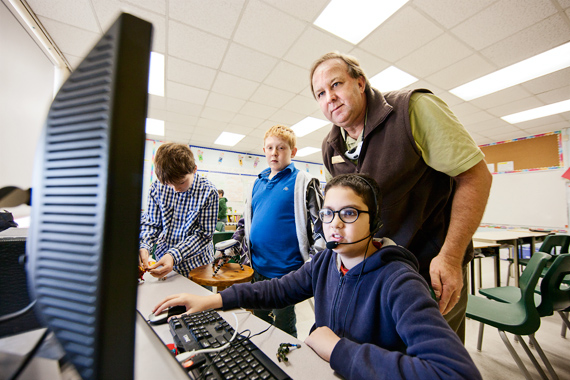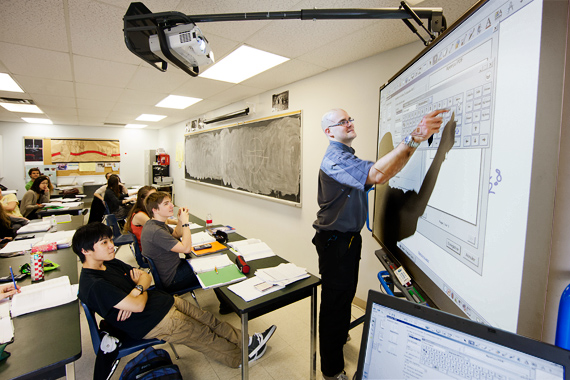Meet four teachers who are using computers, social media, webcams and other tools to help launch learning to a whole new level.
by Gerry Blackwell, with Francis Chalifour, OCT
Photography by Kevin Hewitt
If there’s one area teachers want to know about—and stay on top of—it’s technology in the classroom. So we decided to find out how some leading-edge teachers are using technology in fun, creative ways to better engage students, solve particular problems or enhance curriculum materials.
Where did we start looking? At ECOO 2011, the annual conference of the Educational Computing Organization of Ontario, which brought together more than 600 professionals to share best practices and new ideas around using technology in the classroom.
One conference highlight, Minds on Media, featured 12 Ontario teachers demonstrating and coaching others on the exciting ways they use technology. They are exactly the kind of teachers we plan to spotlight in a new Professionally Speaking column on technology in the classroom, launching next issue.
Meanwhile, here’s a look at what four techno-savvy teachers are doing right now-and tips on how to do the same in your classroom.
Danika Barker, OCT
English and media-literacy teacher
Central Elgin Collegiate Institute, St. Thomas

Don’t use
21st-century tools while hanging onto 19th-century teacher-centric pedagogy. Let students lead a little
Problem: How to make texting Grade 12s relate to the works of Shakespeare.
Solution: Teach using the social-media tools they know, including blogs and Twitter.
Lessons learned: Use a variety of online tools. Ask your students about their favourites, Barker suggests. Her latest experiment: Getting students to role-play Hamlet, in Twitter. “I think it will help them understand the play better,” she says. “And I think it’ll be fun.”
Barker also regularly uses Ning, a subscription service that lets teachers set up private Facebook-like social networking sites. “This is an environment they’re so familiar with. They pick it up quickly,” she says. “But it’s also really conducive to collaboration.”
Each student uses a personal Ning page to blog regularly about in-class discussions. Barker marks their posts. They also have to comment on two other students’ posts and respond to comments on theirs.
Observations: The comment requirement is key, Barker believes. “That’s where the real power is. This is a living document. It’s not like, ‘It’s done, I’ve handed it in. I’m not going to think about it anymore.’ The conversations keep going.” The blog posts also become idea generators for end-of-semester essays. Most students tag posts with keywords, Barker notes, making them easy to sort and search later.
She also lets students produce summative work using multimedia tools such as Glogster, an online service for creating multimedia posters; Bitstrips, for creating comic strips; or Voicethread, a multi-faceted online collaboration tool.
You can do it too
You’ll need:
- student access to computers
- online service subscriptions; Twitter is free, Ning (ning.com) is $2.95+/month per class
- Subscribe to a service.
- Follow instructions to set up students with accounts or personal spaces at class site.
- Issue instructions to your class.
- Monitor and assess.
Helpful hints
Choosing the right tool for the job is key, Barker says. If you’re assessing their ability to write proper paragraphs, it’s pen and paper. But if you’re testing their grasp of a concept, letting them use media tools like Glogster can be a huge motivator and helps accommodate different learning styles.
Don’t make the mistake of implementing 21st-century teaching tools while hanging on to 19th-century teacher-centric pedagogy, she adds. Let students lead a little.
Kent Manning, OCT
Grade 6 teacher
Harmony Public School, Corbyville

It's not quiet. It's noisy. Boys usually like to have mayhem.
Problem: How to inspire boys, especially problem students, to want to write.
Solution: Hide the writing in projects to create stop-motion animated movies.
Lessons learned: “The data shows there’s an incredible gender gap with writing,” Manning says, but adds that boys will perform if teachers provide classroom experiences that motivate them. His stop-motion projects have seen tremendous success with previously unengaged students. They’re inspired to work hard, developing and expressing story-writing skills.
Students form groups, collaborate on writing an original story, plan how to present it using storyboarding, then bring toys from home—cars, figurines and so on, as props and characters —and use a webcam and Ministry—licensed Frames software to produce movies. “These are budding Tim Burtons,” Manning says.
While the final product may not be text, writing a script is still writing, he points out. Projects require language skills and a grasp of beginning-middle-end story structure, so meet curriculum objectives.
Observations: Manning, a board ed-tech consultant at the time, first experimented with introducing media production to motivate boys a few years ago. It worked: Boys’ writing-test results rose; office referrals fell.
Anecdotal evidence is compelling too. This year, one AIP (Autism Intervention Program) boy, after struggling with other writing activities became so enthused that he asked to do extra stop-motion assignments. “That’s just music to my ears,” Manning says.
You can do it too
You’ll need:
- one classroom computer (Intel® Core™ Duo 1GHz+, Windows XP or Mac OS 10.5 and up)
- Frames software (free)
- a webcam or camcorder that can connect to a computer
- a clear tabletop for building movie sets
- Check that Frames is on your classroom computer and familiarize yourself with it.
- Visit tech4learning.com/frames/resources and read primers on clay animation and digital storytelling.
- Form students into groups or let them form their own.
- Allow one period for groups to develop stories and project proposals (see sample form at tech4learning site).
- Allow at least one period for each green-lighted group to produce its movie.
Helpful hints:
Be prepared for disruption during video production, especially with boys. “It’s not quiet,” Manning warns. “It’s noisy. Boys usually like to have mayhem.”
Mali Bickley, OCT
Grade 5 teacher
Fieldcrest Elementary School, Bradford

The kids are so excited. Every time we do this, it’s like a miracle
Problem: How to inspire Net-generation kids and build awareness of social justice issues.
Solution: Get involved in online collaborative projects with classes in other countries.
Lessons learned: Nothing inspires Bickley’s kids to work at curriculum-based learning like the international projects she sets up several times a year. “It’s always the highlight of their week,” she says.
The International Education and Resource Network (iEARN), organizes projects in over 130 countries. (Bickley is one of two iEARN co-ordinators in Canada.) iEARN matches classes, provides a facilitator, and gives teachers step-by-step instructions and help with lesson planning. The customizable projects cover many different subjects.
Students work on common assignments, exchange research, share work and chat in forums. Sometimes they meet in video conferences. In a recent project, Bickley’s class worked with one in Japan. The students researched water-quality issues in their respective countries while learning about each other’s cultures. They collaboratively created a huge collage-style banner and finished with a Skype-powered video conference.
A project with a school in Kandahar, Afghanistan looked at how life in a war zone affects kids and developed ideas on how to become a peace ambassador.
Observations: Bickley shows one of the colourful books the Afghani students produced to summarize the project. “So that’s real, authentic learning, for a purpose. My kids were still writing; they were meeting all the [curriculum] objectives — but they said I tricked them into it.”
More teachers should be trying iEARN projects, Bickley believes. Setting them up isn’t as daunting as it might seem. Kids and most teachers already know the technology. “They’re using social media to connect anyway,” she notes. “This is a way to do it meaningfully, responsibly, respectfully.”
You can do it too
You’ll need:
- at least one Internet-connected computer
- a webcam, if video conferencing
- iEARN membership (free)
Steps:
- Visit media.iearn.org/request and register with iEARN.
- Go to media.iearn.org/projects and choose an appropriate project.
- List your objectives and time frames.
- Email the project facilitator.
(For more steps, surf to iearn-canada.org/involved.htm .)
Helpful hints: “At first, it takes more energy to teach this way,” Bickley says. “But it’s also more energizing. The kids are so excited. Every time we do this, it’s like a miracle.”
Charles Corradini, OCT
Mathematics teacher for Grades 11 and 12 and in the International Baccalaureate program, Collège français, Toronto

Technology really can make our job easier and appeal to students — regardless of learning style.
Problem: Enable students to learn math skills without having to write everything down.
Solution: Use computers to share resources online.
Lessons learned: There are lots of sites that explain math problems, but not many of them provide problem-solving models.
Khanacademy.org explains basic concepts. For more advanced concepts, ocw.mit.edu/index.htm (in English) may be helpful. For solving equations or studying functions, wolframalpha.com (in English) is extremely practical.
Because students do not have to write out exercises, attention problems are minimal. Plus, students are often impressed by software, which may increase their motivation, making classroom management easier. Finally, this approach is good preparation for the course format they may have at university, where technology is ubiquitous.
Observations: Students can really focus on problem solving without wasting time writing, because
course content is posted online.
You can do it too
You’ll need:
- an interactive whiteboard (if possible)
- an Internet-based document-sharing system (if not, a scanner will serve the purpose)
- Set out the exercise on the interactive whiteboard.
- Save the page as a PDF.
- Post it on Cyberquartier (the online resource-sharing tool of our district school board, Viamonde).
Helpful hints:
Don’t be afraid to try new ways of doing things, especially in information technology. An interactive whiteboard is simple to use, and tools are becoming more efficient. Don’t hesitate to ask for help from other educators or learning consultants. Technology really can make our job easier and can appeal to students, regardless of learning style.
-Francis Chalifour, OCT
Inspired?
So were we. That’s why we are launching our new Tech Class column. Every issue, we will show you how a real teacher is using technology to enhance learning in his or her classroom — along with practical, step-by-step instructions should you wish to do the same.
Welcome to the future!
